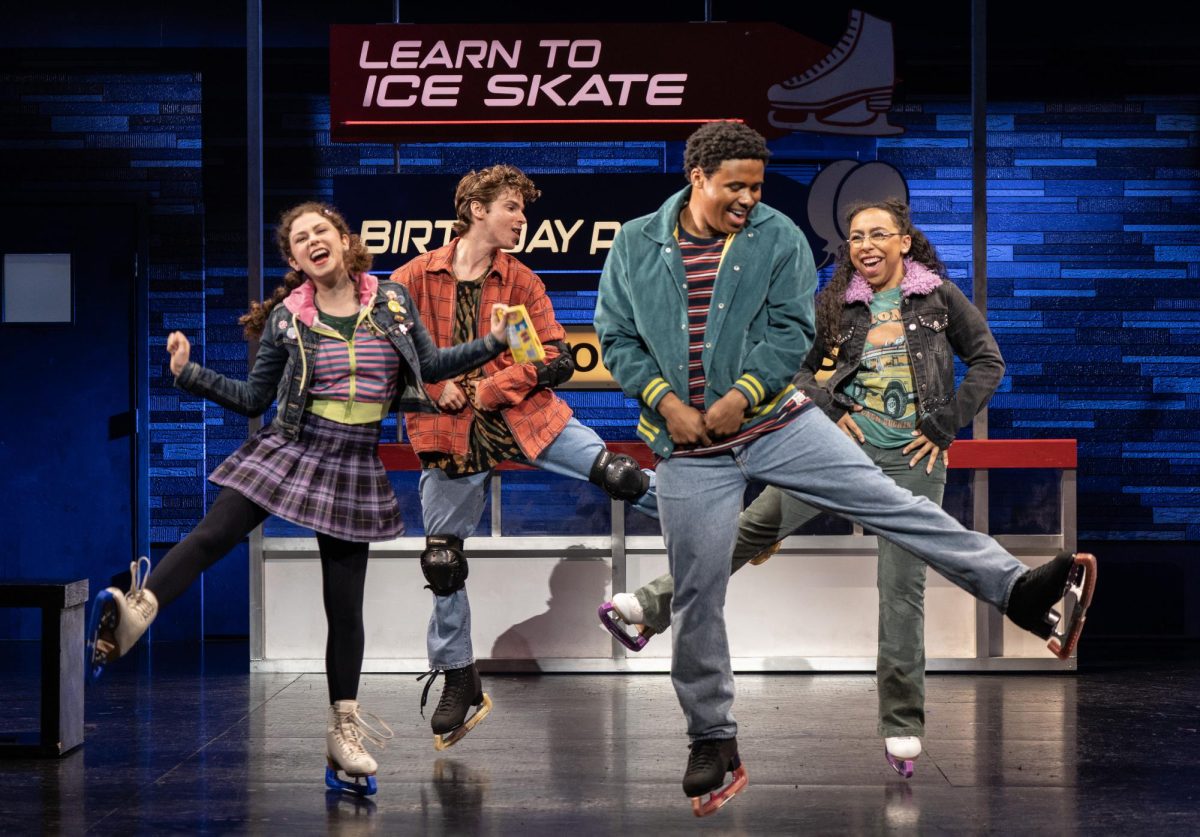The beauty of stories set in teenage uncertainty is how directly they can get to the heart of all the nuances of being human. Suspend your disbelief, and embrace the absurd. “Kimberly Akimbo,” which made its National Tour stop at the San Diego Civic Theatre this past Oct. 8 to Oct. 13, is a Broadway show that intends on doing just this — giving hope to the hopeless, action to the hopeful, and contentment within all the other contradictions with which we exist — and almost succeeds.
With a run-time of about two and a half hours, this five-time Tony Award-winning musical follows an almost-16-year-old girl named Kimberly Levaco (Carolee Carmello) who has just moved to Bergen County, New Jersey with her alcoholic father Buddy (Jim Hogan, who originated the role) and narcissist mother Pattie (Dana Steingold). Kimberly is diagnosed with a rare genetic disease that ages her body four to five times faster than average. Her condition anticipates a life expectancy of 16 years.
The show opens with “Skater Planet,” a classic Broadway opening number at the ice-skating rink where Kimberly’s love interest, tuba-player Seth Wheebis (Miguel Gil), works. We are introduced to a company of deeply uncool show choir-obsessed teens — Delia (Grace Capeless), Martin (Darron Hayes), Teresa (Skye Alyssa Friedman), and Aaron (Pierce Wheeler) — who want nothing more than to beat their rival West Orange and make it to States. While the show is set in 1999, their characterization is that which can only exist and be understood in this audience’s post-Glee reality. Their backing vocals, ad-libs, and harmonies spell out the tortures of their theater-kid-paradigmatic unrequited love circle: Martin (gay) is in love with Aaron (straight) who’s in love with Delia (lesbian) who is pining for Teresa (straight).
Act 1 follows standard Broadway procedure to a tee, moving from extravagant full-cast performances to soulful solos, and back again to high-energy choreographed numbers which reveal each character’s primary interests and motivations.
Kimberly and her classmates navigate high school with an appropriate amount of trepidation, concerned about their grades and practicing how to kiss. The show does well in capturing the sweetness, playfulness, and nervousness of this in-between age. Their worlds may appear small to us, but they aren’t to them, and so we share in the weightiness of all their teenage angst.
For example, in “Make a Wish,” Kimberly pens a letter to the Make-A-Wish Foundation of New Jersey, asking for everything from a wild international adventure to a home-cooked family dinner — to live “like normal people live / however normal people live.” Carmello delivers a stunning and heartbreaking performance, capturing the dichotomies of a wonderfully teenage spirit worn down by a dysfunctional home life, a lonely school career, and the freedoms and limitations of an adolescent existence.
This insecurity is magnified in the behavior of the adults in Kimberly’s life, who are little more than teenagers themselves. Pattie and Buddy, who became pregnant with Kimberly in high school, are stuck in the past, envisioning the alternate paths their lives could have taken. Hogan and Steingold’s portrayals of their respective characters are nuanced and sympathetic to the pain of lost adolescence without removing their responsibility for how they mistreat Kimberly. However, the show gives them very little stage-time to display all this dimension.
Debra (Emily Koch), Pattie’s sister, is the adult we meet last, appearing suddenly from behind a bookshelf in Kimberly’s school library where she had been living. Koch’s portrayal of this comic relief character, a scrappy parolee and con-woman here to recruit Kimberly into carrying out a check fraud scheme, is a hilarious interpretation of a character who exists only as a plot device.
The end of Act 1 turns a bad day into good with a surprise birthday party for Kimberly thrown by Seth at the ice-skating rink. The number is full of hope, so much so that even the least cynical person is left anticipating the inevitable downturn which must follow in the second act.
Act 2 drops us in the Levaco’s basement, where we see Debra training the kids in fraud (“How to Wash a Check”). The plot starts shapeshifting in ways that truly feels out of nowhere — Seth goes through what feels like an obsolete identity crisis, the show choir kids’ love circle is abruptly resolved with a tactless Debra one-liner, and Buddy randomly gets a solo with “Hello Baby.”
All the songs of the second act function too one-dimensionally to feel like they truly develop any character. Any sincerity in the lyricism is too-often contrasted callowly by an isolated ukulele accompaniment and the dialogue can’t decide whether it infantilizes or empathizes with 16-year-old-hood and the realities of living with a disability. While this is forgivable when the musical is good, it is bafflingly tone-deaf when it isn’t.
In the aptly-named “The Inevitable Turn,” Kimberly’s family sits around a dinner table performing normalcy as she wished so hard for, but each character breaks from the scene to sing a self-fulfilling prophecy of dysfunction for the family unit. We learn the real reasons and conflicts that led them to move away from their hometown, which again have little to no value in affecting the show’s action besides shock, and the night ends with Kimberly in the hospital, having suffered a cardiac event. The show ends without really tying up any of the plot-holes that develop through the rising action.
Sitting in the audience as an observer of this rapid mood-swinging messiness, I found myself going back and forth about the incoherency of the story and the very real feelings it inspired in me nonetheless.
It’s difficult to speak about a show like this which was so mediocre on paper but not in heart. I have personally experienced none of this variation on a trailer-trash escapee storyline, but the kinship I felt with each character’s fears, impulses, heartache, and joy are undeniable. One of the best lines of the show comes when Kimberly comes to terms with the fact that, while looking towards the future is her curse, it is the solution for her classmates.
“Kimberly Akimbo” is nihilist at the highest cost, centering a girl whose young life is a ticking clock towards death. She grows up too fast, not only because of her trauma at home, but in visceral visibility in body. She is authentically herself at all times, too young to be trained out of it by society, but too old to not know when she will be punished for it.
Though not the strongest play, “Kimberly Akimbo”’s self-awareness and utilization of gimmicky live theater allows it to accurately mirror the incoherency of life itself. Being human isn’t one-dimensionally beautiful; it is crazy and devastating and ecstatic and a million other things, and this show portrays it all honestly. I wonder whether the lack of clarity in the second act is the result of poor writing or a reflection of the randomness of our messy reality, where nothing seems more important than another until we see it in hindsight.
“Kimberly Akimbo” argues that a life too examined is a life unlived. It doesn’t bother to ask whether we are helpless to our circumstances; it already knows what we can’t control. Instead, the show asks us whether our ability to live authentically is truly immovably challenged by our circumstances like we may think, and it tells us that, whatever has happened or will happen, we are all capable of pursuing our own happinesses.
Photo by Joan Marcus for San Diego Broadway










